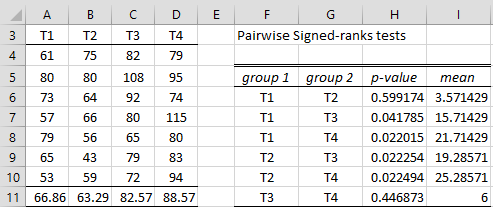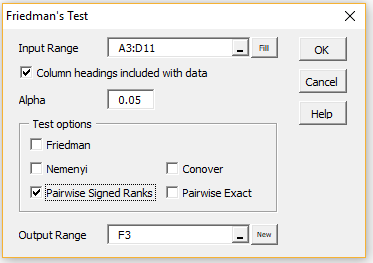Objective
In Multiple Paired t-Tests we describe how to conduct multiple paired sample t-tests using the approaches for dealing with familywise error described in Dealing with Familywise Error. The same approach can be used when the assumptions for the t-test are not met, and so multiple signed-rank tests are employed instead. We illustrate this approach by repeating Example 1 of Multiple Paired t-Tests using multiple signed-rank tests.
Example
Example 1: A new drug is being tested for its effectiveness over a period of 4 weeks (T1 = baseline, before the drug is administered, T2, T3, T4 = week of first, second, and third treatments, respectively). The measurements are shown on the left side of Figure 1.
Figure 1 – Pairwise signed-ranks tests
As described in Multiple Paired t-Tests, there are C(4, 2) = 6 pairs of measurements (as shown in range F5:G11). We can perform a signed ranks test for each of the 6 pairs by using the SRTEST function, with the p-values and mean differences shown in columns H and I respectively. From the data in range F6:H11, we can perform any of the multiple comparison tests described in Dealing with Familywise Error.
Using Friedman’s Test
We can also the Friedman Test data analysis tool to create the p-values shown on the right side of Figure 1. This is done by pressing Ctrl-m and selecting the Analysis of Variance option and then the Friedman Test option from the dialog box that appears (or from the ANOVA tab when using the Multipage interface). In either case, fill in the dialog that appears as shown in Figure 2.
Figure 2 – Selecting the Pairwise signed-ranks tests option
The output is shown on the right side of Figure 1. Since the samples are quite small, it would be better to use the signed-ranks exact test instead of the normal approximation. This is done by choosing the Pairwise Exact test option in the dialog box shown in Figure 1 The result is shown on the left side of Figure 3, along with the Hochberg Test follow-up analysis (using the Multiple Tests data analysis tool described in Dealing with Familywise Error on the input range K6:M11) shown on the right side of the figure.
Figure 3 – Pairwise signed-ranks exact tests
Examples Workbook
Click here to download the Excel workbook with the examples described on this webpage.
References
Wikipedia (2018) Wilcoxon signed-rank test
https://en.wikipedia.org/wiki/Wilcoxon_signed-rank_test
Howell, D. C. (2010) Statistical methods for psychology (7th ed.). Wadsworth, Cengage Learning.
https://labs.la.utexas.edu/gilden/files/2016/05/Statistics-Text.pdf


